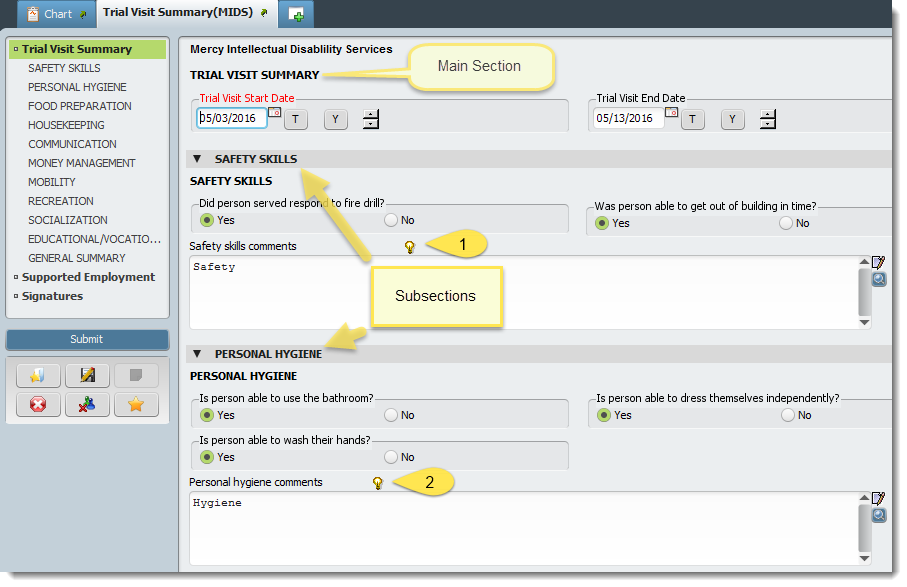
The Trial Visit Summary is used to enter an assessment of an individual’s skills, condition, and employment during a Trial Visit Pre-Admission to a Residential Program. This form must be completed during the Trail Visit. For FBVR information, please use the Trial Assessment Trial Assessment .
Directors/Supervisors, ID Staff, and Nurses may complete the form. All Avatar users may view the form.
The Trial Visit Summary is client and episode specific and can be opened from the Home View, within a client's chart, or via menu path Avatar CWS/Mercy Modeled Clinical Forms/Mercy ID Forms/Trial Visit Summary(MIDS).
The form is separated into sections and subsections that will bring the user to that section when selected. The main sections are Trial Visit Summary and Supportive Employment. The following image is the form as it opens to the top of the Trial Visit Summary section. Note that the Trial Visit Start Date is a required field in the Trial Visit Summary section. The first 2 subsections are also pictured here; Safety Skills and Personal Hygiene. The subsections under Trial Visit Summary are used to record individual information about functioning and aptitude in general.

![]() 1 - "Fire drills, telephone usage, hot/cold water, poisons, ability to notify staff, appropriate party in the event of emergency, ability to lock apartment door and use key, ability to cross streets."
1 - "Fire drills, telephone usage, hot/cold water, poisons, ability to notify staff, appropriate party in the event of emergency, ability to lock apartment door and use key, ability to cross streets."
![]() 2 - "Ability to care for personal hygiene/self care."
2 - "Ability to care for personal hygiene/self care."
Food Preparation deals with making meals and kitchen safety, as well as general comments.
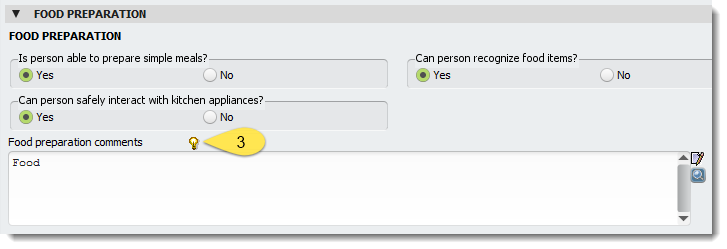
![]() 3 - "Ability to use stove, prepare meals, prepare menus, recognize food items."
3 - "Ability to use stove, prepare meals, prepare menus, recognize food items."
Housekeeping asks about general information regarding household chores, as well as general comments.

![]() 4 - "Ability to participate in cleaning."
4 - "Ability to participate in cleaning."
Communication is used to capture individual’s ability to understand and express verbal communication and/or sign language, as well as general comments.
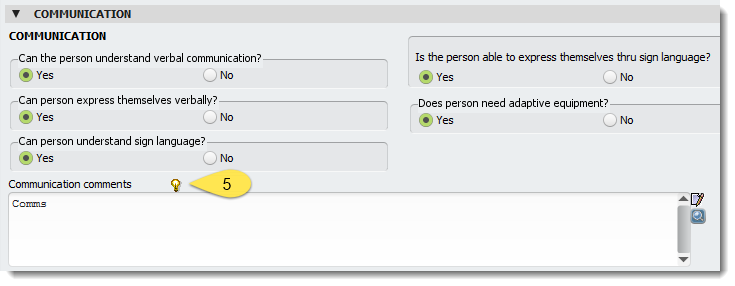
![]() 5 - "Ability to express self verbally and in writing or through sign language/adaptive equipment."
5 - "Ability to express self verbally and in writing or through sign language/adaptive equipment."
Money Management asks about an individual’s ability to recognize, carry, and use money, as well as general comments.
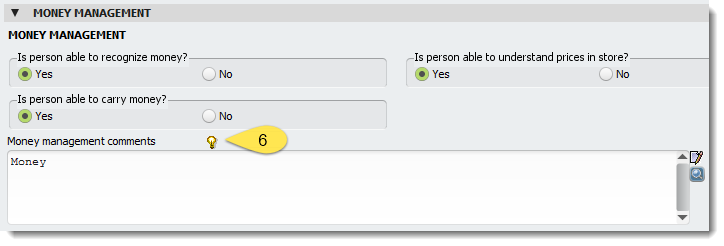
![]() 6 - Ability to recognize money, safely carry money, understand prices in stores."
6 - Ability to recognize money, safely carry money, understand prices in stores."
Mobility is used to capture information about the individual’s ability to travel by walking or public transport, move through the community safely, and general comments.
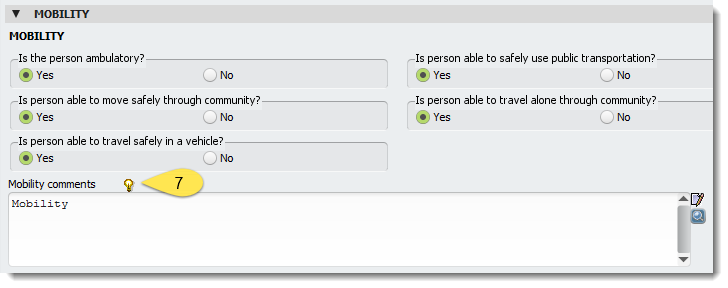
![]() 7 - "Ability to use public transportation, safely move about apartment, safety within the community."
7 - "Ability to use public transportation, safely move about apartment, safety within the community."
Recreation records if an individual can independently choose recreational activities and general comments.

![]() 8 - "Ability to express choice of recreational activities, appropriateness of activities."
8 - "Ability to express choice of recreational activities, appropriateness of activities."
Socialization asks if an individual can exhibit appropriate behavior and personal/sexual interactions with others, as well as general comments.
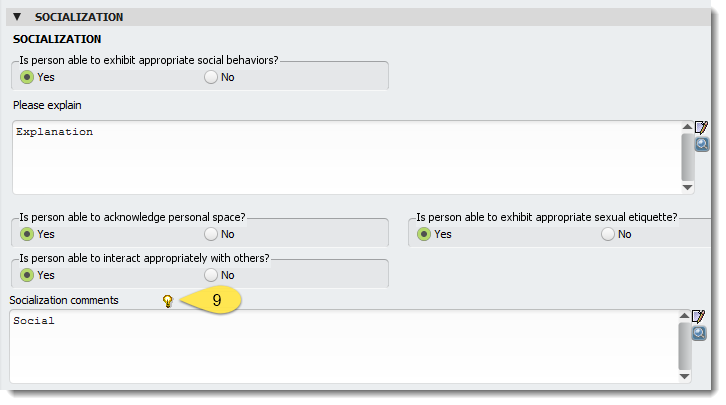
![]() 9 - "Appropriateness of interaction, sexuality assessment."
9 - "Appropriateness of interaction, sexuality assessment."
Educational/Vocational activities and access are recorded, as well as general comments.

![]() 10 - "Contact with Day Program."
10 - "Contact with Day Program."
General Summary is used for recording the individual’s current independent functioning.

The Supported/Supportive Employment section is used to assess and discuss the opportunities for community employment.
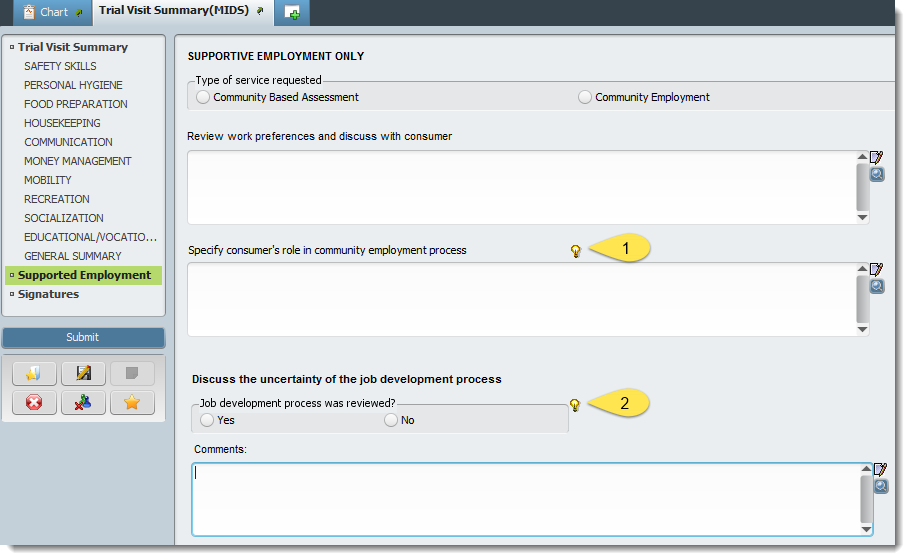
![]() 1 - "Resume writing, job search, returning employer phone calls, job application process and communication between Employment Specialist and Person Served."
1 - "Resume writing, job search, returning employer phone calls, job application process and communication between Employment Specialist and Person Served."
![]() 2 - "No guarantee of outcomes, contract to do the best to meet the needs/interests of the person served. Explain time management with employment specialist."
2 - "No guarantee of outcomes, contract to do the best to meet the needs/interests of the person served. Explain time management with employment specialist."
Click the blue Submit button to enter the form into the client’s record. A printable form of the completed summary will automatically open and be ready for printing. All signatures can be gathered on the form and forwarded to HIM for scanning into the record as per company procedures. HIM Processes
Any checkbox/radio button selections made in error can be cleared by selecting the entry and pressing F5 on your keyboard.
Mouse over or click the Light Bulb icons to read Help Messages.
The Trail Visit will count as an Episode in the client record. To admit the patient into a program, first complete a Discharge and then Admit normally. Information about Discharging clients can be found here - Discharging A Client Information about Admitting clients can be found here. Admitting A Client
Menu Location - Avatar CWS/Mercy Modeled Clinical Forms/Mercy ID Forms/Trial Visit Summary(MIDS)
SQL Table(s) - SYSTEM.ID_trial_visit_summary
RAD Envelope (if applicable) - ID_trial_visit_summary
Article ID: 57
Created On: Wed, Jun 29, 2016 at 6:00 PM
Last Updated On: Mon, Aug 8, 2016 at 8:54 AM
Authored by: John Cookson [jcookson@fivebase.com]
Online URL: https://www.mercykb.com/article.php?id=57